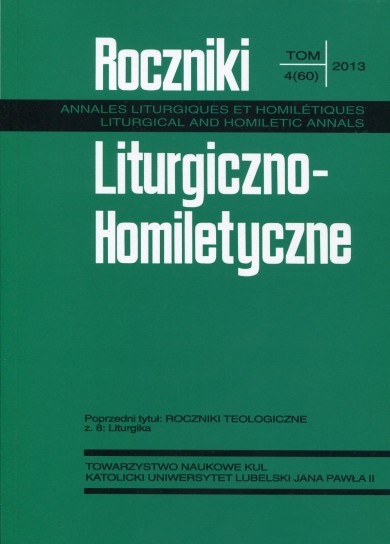ZWIĄZEK TREŚCI TEOLOGICZNYCH FORMUŁ ZAWARTYCH W „CREDO” I EUCHOLOGII MSZAŁU RZYMSKIEGO 2002
CONNECTION OF THE THEOLOGICAL FORMULAS OF “CREED” AND THE EUCHOLOGY OF THE ROMAN MISSAL 2002
Author(s): Włodzimierz MocydlarzSubject(s): Christian Theology and Religion
Published by: Katolicki Uniwersytet Lubelski Jana Pawła II - Wydział Teologii
Keywords: CREDO; MISSALE ROMANUM; MISSAL; EUCHOLOGY
Summary/Abstract: e have tried to show in our research the connection formulas of faith in God and the Church in relation to the Mass euchology the sense in which the profession of faith in God (Credo In unum Deum) is, and what is not identical to an article of faith in the Church (et... Ecclesiam). The similarity of these articles of faith has analogous nature, but it is not identical, because where there are similarities, the differences are even bigger, particularly in relation to God. The belief that the Church is holy and universal (catholic), that is one and apostolic, is inseparable from faith into the Triune God. But when, in the Apostles’ Creed we profess faith in the Church (et...Ecclesiam), then we use here a different form than in the article regarding belief in God (Credo in... Deum), because God is the Creator, and the Church is His creation, because the goodness of God is the source of all the gifts which the Church enjoys. The difference in the meaning of the creed in unum Deum, and et... Ecclesiam resolved so clearly the Catechism of the Catholic Church (cf. 750). This is confirmed by the Pope Benedict XVI, and even those of the theologians who wrote before its release in 1992. Even meta-historicity and theandric reality of the Church in terms of Paul Evdokimov did not storm the structure of the economy of salvation, which was created and revealed to us by God In Jesus Christ and the Church after Pentecost. It provided us in the Church and through the Church (and its liturgy). According to Evdokimov, the mystery of the Church still comes from the creative act of God, and it remains creation. The decisions of the ancient doctrine of the Church and later on over the centuries, remain no doubt that the Apostolic Church is that only through the saving work of Christ the Lord, and their credibility derives from its permanent presence in the Church. However, on the other hand, we know that He identifies himself with the Church (with his brothers, with their followers), as it is seen in a very explicit way in the testimony of Acts, the risen Jesus in dialogue with Saul (cf. Acts 9:4), which has immediately understood that by persecuting the disciples (the Church), haunted by the one who blinded him with its splendor on the road to Damascus. Then, the converted Saul–Paul, develops profound doctrine of the Church as the Mystical Body of Christ. But never in a physical manner. He does not identify the Church and Christ. This can be noted especially in his letters to the local communities. For example a sin ful Church in Corinth (1 Cor 5), which Paul had to rebuke. Besides, a very eloquent text, talking about rectifying the identified shortcomings sufferings of Christ (Col 1:24). We can clearly see that it is a body which is the Church, its good that is done by the suffering endured in the flesh by Paul himself for the name of Jesus. So neither Paul nor the Church is presented as a perfect one. A similar picture of the Church emerges from Missal's euchology,
Journal: Roczniki Liturgiczno-Homiletyczne
- Issue Year: 2012
- Issue No: 3 (59)
- Page Range: 91-113
- Page Count: 23
- Language: Polish

